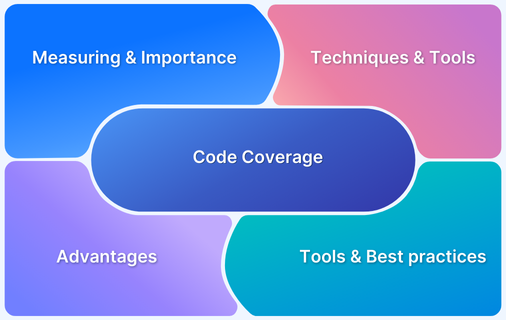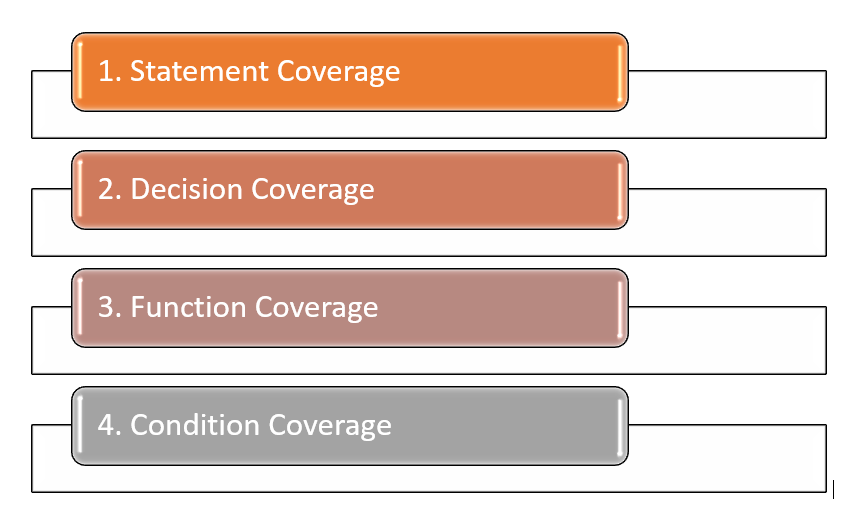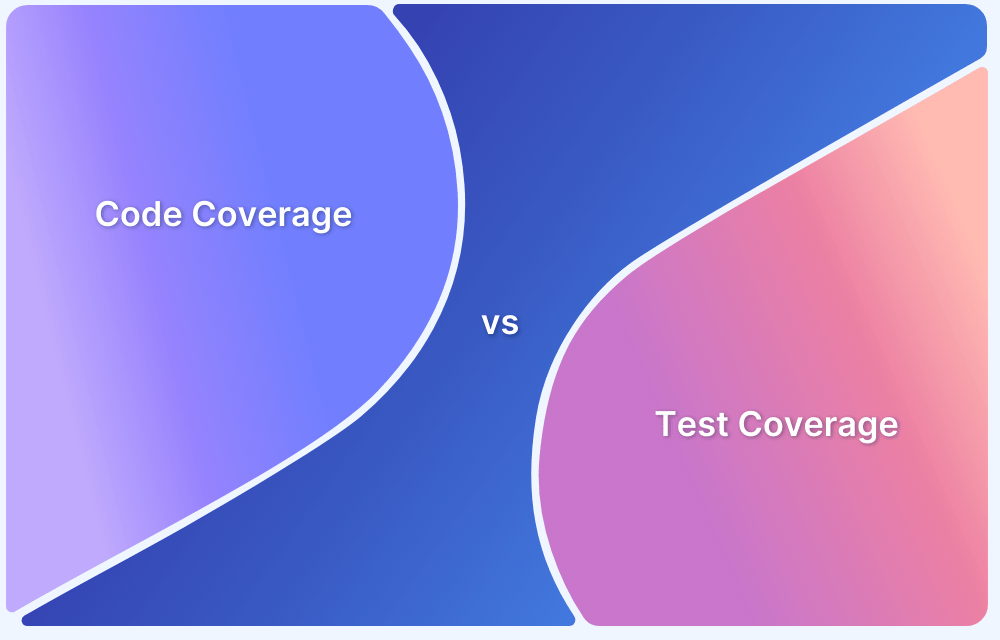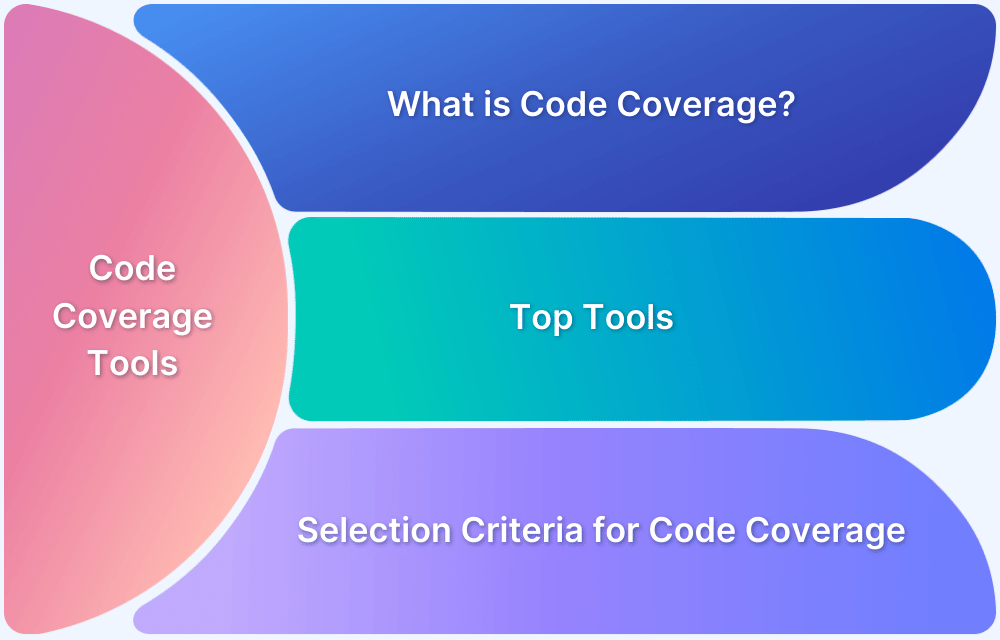Code coverage plays a crucial role in delivering solid, dependable software. Showing which parts of the code haven’t been tested helps teams catch hidden bugs, build stability, and avoid issues in production.
Overview
What is Code Coverage?
Code coverage is a metric that measures the percentage of code executed during testing to assess test effectiveness.
How to Measure Code Coverage?
The formula for Code Coverage is:
Code Coverage (%)=( Total number of lines (or statements) in code/
Number of lines (or statements) executed )×100
Code Coverage Techniques:
- Statement Coverage
- Branch (Decision) Coverage
- Function Coverage
- Condition Coverage
- Path Coverage
- Line Coverage
- Loop Coverage
Code Coverage Tools:
- Cobertura
- Clover
- Gretel
- Kalistick
- JaCoCo
- JTest
- OpenCover
- Emma
- GCT
This guide explains code coverage, its significance, techniques, and more.
What is Code Coverage?
Code coverage is a metric that measures the percentage of a codebase executed during testing. It helps to identify untested areas and improve software quality.
In other words, it describes the degree to which the coding of an application has been tested when a particular test suite runs. It is considered one of the forms of White Box Testing and is usually performed by Developers during Unit Testing.
Code coverage scripts generate a report that lists how much of the application code has been executed.
How is Code Coverage measured?
Code Coverage can be calculated using the formula:
Code Coverage Percentage = (Number of lines of code executed)/(Total Number of lines of code in an application) * 100.
If the test suite executes the entire piece of code, including all the loops, branches, functions, function calls, or conditions, then it can be said that the Code Coverage for that piece of code is 100% which means that a quality product will be delivered to the customer.
Why is Code Coverage important?
Code Coverage is essential because it:
- Helps in maintaining the code base while also letting any features be added later with little-to-no-efforts.
- Helps in exposing bad, dead, and unused codes. Thereby maintaining the product quality.
- Helps in finishing the software development process faster, thus, helping in increasing productivity and efficiency.
- Helps companies to launch more software applications in the market in lesser time.
- Helps to increase customer satisfaction resulting in higher ROI.
Read More: Calculating Test Automation ROI: A Guide
Code coverage vs Test coverage (table format)
Code coverage and test coverage are both metrics used to evaluate software testing effectiveness, but they measure different aspects. Code coverage tracks the amount of code executed during tests, while test coverage assesses the extent to which requirements and functionalities are tested.
| Aspect | Code Coverage | Test Coverage |
|---|---|---|
| Definition | Measures the percentage of code executed | Measures the extent of requirements tested |
| Focus | Focuses on code lines, branches, and paths | Focuses on functionality and test cases |
| Purpose | Identifies untested code segments | Ensures all features are adequately tested |
| Goal | Improves code stability and reduces bugs | Validates requirement fulfillment |
| Metric Type | Structural (based on code structure) | Functional (based on requirements) |
| Example | Lines, branches, or statements covered | Use cases, user stories, or features tested |
Read More: Code Coverage vs Test Coverage
Code Coverage Techniques
Following are the major techniques used by companies to measure the lines of code:
 1. Statement Coverage
1. Statement Coverage
Statement Coverage or Block Coverage measures if all the possible executable statements of code have been executed at least once. This ensures coverage of all possible lines, paths, and statements in the source code. Different input values may have to be used to cover all conditions in the source code since it may have a wide variety of elements, such as operators, looping, functions, exception handlers, etc.
Statement Coverage can be calculated by:
Statement Coverage Percentage = (Number of statements executed)/(Total Number of statements)*100
Consider the below source code example (it contains 7 statements) to calculate Statement Coverage:
Sum (int x, int y) { int result = x + y; If (result> 0) Print ("Positive Result", result) Else Print ("Negative Result", result) }
Scenario 1:
x=2, y=3
In the above scenario, the ‘Else’ part of the source code would not get executed since (2 + 3)= positive number.
Sum (int x, int y) { int result = x + y; If (result> 0) Print ("Positive Result", result) Else Print ("Negative Result", result) }
Statement Coverage is equal to (5/7)*100 = 71%
Scenario 2:
x= -2, y= -3
In the above scenario, the ‘If’ part of the code would not get executed since (-2 + (-3))= negative number.
Sum (int x, int y) { int result = x + y; If (result> 0) Print ("Positive Result", result) Else Print ("Negative Result", result) }
Statement Coverage is equal to (6/7)*100 = 85%
This means that with either set of values, our Statement Coverage would not be 100%. In such cases, we may have to execute the tests with all two [(2, 3), (-2, -3)] sets of values to ensure 100% Statement Coverage.
Hence, Statement Coverage covers
- Missing statements
- Unused branches
- Unused statements
- Dead code
2. Branch (Decision) Coverage
Decision Coverage or Branch Coverage ensures that each and every branch appearing in each of the conditional structures gets executed in the source code at least once. It helps in measuring fractions of independent code segments and finding out sections having no branches. Since Branch Coverage measures execution paths, it has more value over Statement Coverage. Hence, 100% Branch coverage implies 100% Statement coverage. The outcome will be binary in this coverage. Hence, both True and False outcomes must be tested.
Decision Coverage can be calculated by:
Decision Coverage Percentage = (Number of decision/branch outcomes executed)/(Total number of decision outcomes in the source code)*100
Consider the below source code example to calculate Decision Coverage:
Sample (int x) { If (x >= 5) x = x * 2 Print (x) }
Scenario 1:
x= 2
In the above scenario, the outcome = No since 2 <= 5.
Sample (int x) { If (x >= 5) x = x * 2 Print (x) }
Decision Coverage = 50%
Scenario 2:
x= 7
In the above scenario, the outcome = Yes since 7 >= 5.
Sample (int x) { If (x >= 5) x = x * 2 Print (x) }
Decision Coverage = 50%
This means that with either set of values, our Decision Coverage would not be 100%. In such cases, we may have to execute the tests with both the values – 2 and 7 to ensure 100% Decision Coverage.
Hence, Decision Coverage covers
- All branches – If, Else, While, Do
- Removes issues happening due to Statement Coverage testing
3. Function Coverage
Function Coverage ensures that all the necessary functions present in the source code are covered during test execution. These functions need to be tested for varying values so that they get tested thoroughly. In the source code, there may be multiple functions, and depending on the input values used, they may or may not be called. Thus, the purpose of Function Coverage is to ensure that we have each function called for.
Function Coverage can be calculated by:
Function Coverage Percentage = (Number of functions called)/(Total number of functions)*100
Consider the below source code example to calculate Function Coverage:
Add (int x, int y) { int result = x + y; If (result> 0) Print ("Positive", result) Else Print ("Negative", result) }
4. Condition Coverage
Condition Coverage or Expression Coverage is used to test and evaluate the variables or sub-expressions in the conditional statement. It ensures that the tests cover both the conditional statement values, i.e., true or false. It also helps to provide proper coverage to the control flow. It offers better sensitivity to the control flow than decision coverage. In this coverage, expressions with logical operands are only considered.
Condition Coverage can be calculated by:
Condition Coverage Percentage = (Number of Executed Operands / Total No of Executed Operands)*100
When each occurring condition is evaluated for both true and false states in the source code, the Condition Coverage would be 100%. If an expression has Boolean operations like AND, OR, or XOR, it indicates total possibilities.
Consider the below example to calculate Condition Coverage:
If (x < y) AND (c > d) THEN
For the above expression, there are 4 possible combinations: TT, TF, FT, FF
Scenario:
x=3, y=4
c=3, d=4
x<y = TRUE, c<d = FALSE which satisfies one of the 4 combinations (TF).
Therefore, Condition Coverage is equal to (1/4)*100 = 25%
Condition Coverage covers
- All the conditional statements in the source code
- All the logical expressions in the source code
If our tests call the ‘Add’ function even once, then we would call this as a 100% Function Coverage.
Hence, Function Coverage covers
- All the functions in the source code
- All the subroutines in the source code
5. Path Coverage
Path coverage ensures that every possible path through the code (different combinations of conditions) is tested. This technique is valuable in functions with multiple conditions and branches, as it helps detect errors that might appear in specific paths.
Example Python Code:
def check_number(num): if num > 0: print("Positive") elif num < 0: print("Negative") else: print("Zero")
Path Coverage Testing:
To achieve full path coverage, tests that explore each path are needed:
- check_number(5) covers the num > 0 path.
- check_number(-3) covers the num < 0 path.
- check_number(0) covers the num == 0 path.
Each test checks a unique execution path through the function, ensuring each possible condition is evaluated.
6. Line Coverage
Line coverage measures whether every line of code is executed during testing. It’s one of the simplest coverage metrics and identifies lines that haven’t been run, which could be areas with untested potential bugs.
Example Python Code:
def sum_positive(numbers): total = 0 # Line 1 for num in numbers: # Line 2 if num > 0: # Line 3 total += num # Line 4 return total # Line 5
Line Coverage Testing:
To achieve full line coverage, tests should ensure:
- Each line is executed, and conditions are both true and false.
Test cases:
- sum_positive([1, 2, 3]) tests all positive numbers, ensuring lines 1, 2, 3, 4, and 5 are executed.
- sum_positive([-1, 2, -3]) tests a mix of positive and non-positive values.
- sum_positive([]) checks the edge case of an empty list, ensuring line 1 and 5 execute without entering the loop.
7. Loop Coverage
Loop coverage ensures that loops are tested with different iteration counts, including zero times (no loop entry), once, and multiple times. This technique is particularly useful for catching errors in loops, such as off-by-one errors or infinite loops.
Example Python Code:
def factorial(n): result = 1 for i in range(1, n + 1): # Loop to calculate factorial result *= i return result
Loop Coverage Testing:
To fully cover this loop, tests should check:
- Zero Iterations: The loop runs zero times (e.g., factorial(0)).
- One Iteration: The loop runs once (e.g., factorial(1)).
- Multiple Iterations: The loop runs multiple times (e.g., factorial(5)).
Test cases:
- factorial(0) verifies the loop doesn’t execute and returns 1 directly.
- factorial(1) ensures the loop runs once, multiplying result by 1.
- factorial(5) checks multiple iterations, testing the loop’s handling of larger values.
Which type of Code Coverage to choose?
Choosing the right type of code coverage depends on the complexity and specific needs of the project. Here is a breakdown to help guide the choice:
| Technique | Description | Best For | Limitations |
|---|---|---|---|
| Statement Coverage | Ensures each statement in the code is executed at least once. | Simple codebases, ensuring basic execution. | Doesn’t cover logical branches or conditions. |
| Branch (Decision) Coverage | Tests every possible branch (true/false) of each decision point. | Code with multiple conditions and decision-making logic. | May require more test cases for full coverage. |
| Function Coverage | Confirms each function in the code is called at least once. | Ensuring all functions are tested, especially in modular codebases. | Doesn’t cover internal logic of each function. |
| Condition Coverage | Tests each individual condition within decision statements. | Code with complex conditional logic, ensuring each condition works as expected. | Can lead to many test cases, especially for multiple conditions. |
| Path Coverage | Covers every possible path through the code, testing all condition combinations. | Complex applications with multiple decision points. | High test case count; difficult for large codebases. |
| Line Coverage | Measures the percentage of lines executed during testing. | Simple projects, providing an overall view of coverage. | Misses specific logic paths and condition combinations. |
| Loop Coverage | Ensures each loop is tested with zero, one, and multiple iterations. | Code with loops, especially algorithms processing collections. | Focused only on loop behavior, ignoring other logic. |
Advantages of Code Coverage
Here are the advantages of using Code Coverage
- It helps in finding new uncovered test cases.
- It enables testers to create extra test cases to increase coverage.
- It helps measure the test implementation efficiency.
- It helps expose bad, dead, and unused code.
- It helps determine the quality and performance aspects of any software.
- It helps develop the software product faster by increasing its productivity and efficiency.
Disadvantages of Code Coverage
Here are the disadvantages of using Code Coverage
- It can not guarantee that all the possible test cases or values of a feature are tested.
- Aiming for a 100% code coverage can cause a lack of robustness in the tests resulting in missing out on capturing the defect-prone scenarios.
- It is impossible to determine how perfectly the code has been covered.
Code Coverage Tools
Here is a quick overview of popular code coverage tools, highlighting key features, pros, and cons to help choose the best fit for your project.
| Tool | Description | Key Features | Pros | Cons |
|---|---|---|---|---|
| Cobertura | An open-source Java tool for measuring line and branch coverage. | – HTML/XML reports – Line and branch coverage – Integrates with CI tools | Open-source, easy setup | Limited language support, lacks advanced features |
| Clover | A Java and Groovy code coverage tool from Atlassian. | – Branch, statement, and method coverage – Historical reports and trends – IDE and CI integration | Comprehensive coverage options | Paid tool, limited to Java/Groovy |
| Gretel | Provides granular control and analysis over code coverage. | – Path and branch analysis – Detailed reporting – Support for C/C++ | Detailed insights for C/C++ | Limited language support, complex setup |
| Kalistick | A cloud-based code coverage tool focused on analysis and optimization. | – Advanced code analysis – Cloud-based, no setup required – Multi-language support | No infrastructure needed, language flexibility | Subscription-based, may be overkill for small projects |
| JaCoCo | Widely-used Java code coverage library integrated with build tools. | – Line, branch, and instruction coverage – Integrates with Maven, Gradle, and CI – Lightweight | Free, robust Java integration | Limited to Java, basic reporting |
| JTest | Parasoft’s tool for Java and C++ code coverage and static analysis. | – Static analysis and runtime error detection – IDE integration – Detailed compliance reporting | Comprehensive feature set | Commercial tool, steep learning curve |
| OpenCover | Open-source .NET coverage tool for Windows environments. | – Statement and branch coverage – CI/CD integration – Visual Studio compatible | Free, .NET-specific | Limited to Windows, lacks advanced features |
| Emma | Lightweight, open-source Java tool for basic coverage. | – Line and block coverage – Quick setup – HTML reports | Lightweight, free | No longer maintained, lacks advanced metrics |
| GCT | Google Coverage Tool for C/C++ with high-precision coverage. | – Multi-coverage types – Detailed C/C++ analysis – Integrates with Google’s testing framework | Precise coverage, robust analysis | Limited to C/C++, setup expertise needed |
Best Practices for Code Coverage
Here are essential best practices to help maximize the effectiveness of your code coverage strategy.
- Set Realistic Coverage Goals: Aim for a practical coverage target that balances testing depth and development speed.
- Focus on Critical Code Paths: Prioritize testing in critical logic, security-sensitive areas, and high-impact features.
- Use Multiple Coverage Techniques: Combine line, branch, and path coverage for a thorough testing approach.
- Integrate Code Coverage with CI/CD: Automate coverage checks in CI/CD to catch issues early and ensure consistency.
- Review and Refine Coverage Regularly: Analyze results often to identify under-tested areas, especially after refactoring.
- Avoid Testing Trivial Code: Skip trivial or low-risk code like getters and setters, as they rarely contain bugs.
- Emphasize Coverage on New Code: Focus on testing new or modified code to prevent introducing untested bugs.
- Leverage Coverage Reports: Use reports to track progress, discuss with developers, and ensure critical areas remain covered.
Conclusion
In a competitive market, delivering high-quality software quickly is a must. Code coverage analysis provides valuable insights, helping developers write clean, reliable code that enhances overall software quality.
In addition to the above-mentioned code coverage tools, you can also check out how BrowserStack contributes to this cause.
BrowserStack’s Test Management tool combines test planning, execution, and reporting in one place. It enables teams to track test coverage and ensure thorough testing. Simple integration and organized workflows help manage coverage across all test cases for consistent, high-quality releases.
In addition, BrowserStack’s Code Quality tools provide detailed insights into code issues, helping teams identify gaps and maintain high standards.
BrowserStack enables developers to catch issues early and consistently deliver reliable, well-tested code.

 1. Statement Coverage
1. Statement Coverage



